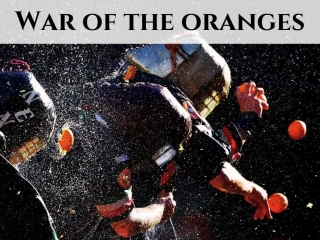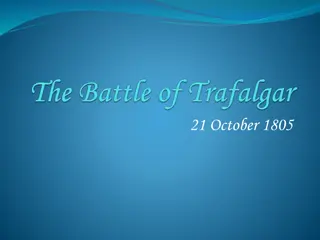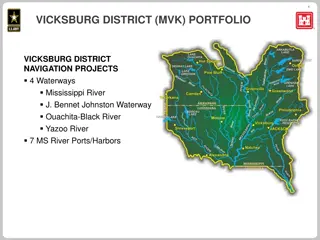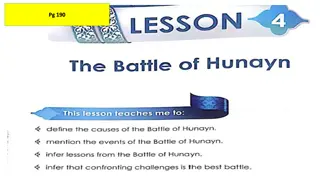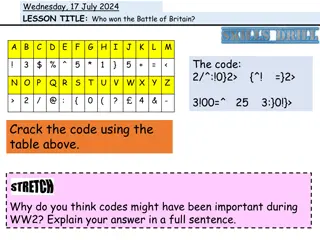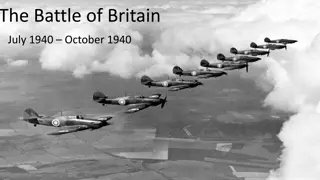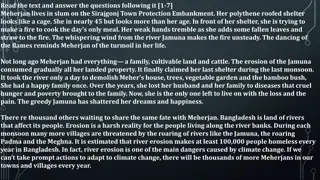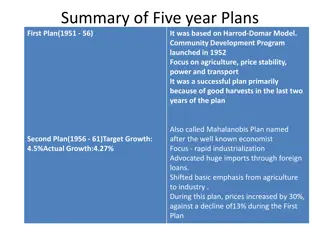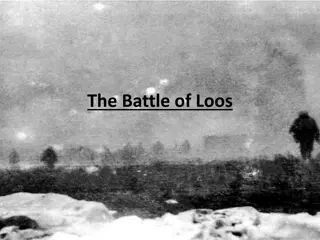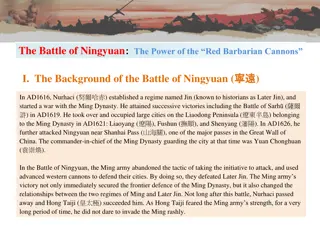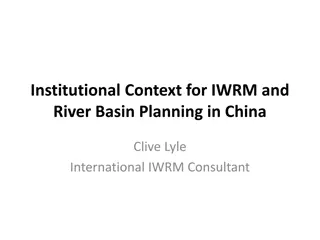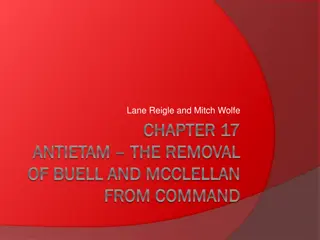The Glorious Glosters at the Battle of the Imjin River, April 1951
Explore and teach the Korean War through Lesson 5.1, focusing on the Battle of the Imjin River where The Glorious Glosters fought bravely in April 1951. Dive into the main developments of the Korean War in 1950-51, analyze key events, and build a narrative using evidence to understand the significance of this crucial battle.
Download Presentation

Please find below an Image/Link to download the presentation.
The content on the website is provided AS IS for your information and personal use only. It may not be sold, licensed, or shared on other websites without obtaining consent from the author. Download presentation by click this link. If you encounter any issues during the download, it is possible that the publisher has removed the file from their server.
E N D
Presentation Transcript
Enquiry 5: The Glorious Glosters What happened at the Battle of the Imjin River, April 1951? 1 Exploring and Teaching the Korean War | Lesson 5.1
Enquiry overview: The Glorious Glosters What happened at the Battle of the Imjin River, April 1951? Lesson 5.1 Lesson 5.2 Use evidence to build a narrative of what happened at the Battle of the Imjin River Write an account of what happened at the Battle of the Imjin River 2 Exploring and Teaching the Korean War | Lesson 5.1
Lesson 5.1 Overview Content covered in the lesson: Lesson 5.1 Background: The main developments in the Korean War 1950 51 Use evidence to build a narrative of what happened at the Battle of the Imjin River Focus: Why we are studying the Battle of the Imjin River Evidence: Making inferences from sources about what happened at the battle Conclusions: What happened at the Battle of the Imjin River? 3 Exploring and Teaching the Korean War | Lesson 5.1
Background: What were the main developments in the Korean War 1950 51? Activity 1 Here is a very basic summary chart of the main phases of the Korean War 1950 51. The diagram would not make much sense to anyone who has not studied the war. Your task is to use the next four pages to add dates, countries, events and other facts and figures that will turn this from a skeleton into a useful summary of the events. Advance & Retreat Inter- vention Invasion Response Stalemate Your teacher can give you your own copy as Resource sheet 5.1A. 4 Exploring and Teaching the Korean War | Lesson 5.1
Map 1: The Korean War to summer 1950 25 June 1950 After skirmishes across the 4km-wide security zone (which had been set up at the 38th parallel), the ROK were surprised when the NKA invaded with 130,000 troops. 28 June 1950 Seoul, the capital of the ROK, fell to the NKA. Summer 1950 ROK and UN forces were pushed all the way to Pusan in the south-east corner of the ROK. Your teacher can give you a glossary, Resource sheet 5.1B. 5 Exploring and Teaching the Korean War | Lesson 5.1
Map 2: The Korean War to October 1950 15 September 1950 US invasion at Inchon. This split the NKA and allowed the ROK and UN to break out of Pusan. 7 October 1950 US/UN/ROK forces, under the leadership of American General Douglas MacArthur, crossed the 38th parallel and invaded the DPRK. Their forces moved north towards the Yalu River (the border with China). 6 Exploring and Teaching the Korean War | Lesson 5.1
Map 3: The Korean War to January 1951 19 October 1950 China declared war on the US/UN/ROK, claiming that the invasion of the DPRK was an act of aggression. Thousands of Chinese soldiers crossed the Yalu River. November 1950 US/UN/ROK pressed on northwards. They captured Pyongyang. Winter 1950 Chinese forces, under the leadership of General Peng Dehuai, engaged with the UN forces in a number of battles. The UN defence crumbled and they were forced to withdraw from the DPRK. January 1951 China pushed south over the 38th parallel and took Seoul. 7 Exploring and Teaching the Korean War | Lesson 5.1
Map 4: The Korean War to April 1951 15 March 1951 After four counter- offensives, the UN recaptured Seoul. The Chinese were overstretched and forced to retreat. April 1951 General MacArthur publicly called for atomic weapons to be used against Beijing to force China out of the war. He was sacked by President Truman and replaced by General Matthew Ridgway. Truman, Ridgway and the UN advocated securing a divided Korea and established a defensible line (known as Kansas) below the 38th parallel. 8 Exploring and Teaching the Korean War | Lesson 5.1
Focus: Why are we looking at the Battle of the Imjin River? Activity 2 How do we know that the Battle of the Imjin River was significant? Who felt that it was significant? These photos show the Gloucester Valley Battle Monument built by the people of South Korea. It commemorates the Battle of the Imjin River. The hill where the main battle took place has been renamed Gloster Hill. 9 Exploring and Teaching the Korean War | Lesson 5.1
The Chinese Spring Offensive Check your understanding 22 April 1951 Chinese General Peng amassed over 300,000 soldiers. He planned to break holes through the UN defensive, recapture Seoul and push the Westerners out of Korea. The PLA (People s Liberation Army) were only a small portion of the soldiers that made up the Chinese communist forces. Peng sent numerous patrols to probe the UN and ROK lines for weaknesses, then sent in huge numbers of less experienced troops to overwhelm the enemy, followed by his best men in the PLA to secure positions. 10 Exploring and Teaching the Korean War | Lesson 5.1
The British Forces The UN front line forces were deployed along the 38th parallel to meet the Chinese advance. The British 29th Infantry Brigade (BIB) and supporting UN and ROK forces were positioned to stop a Chinese advance on Seoul and to protect the only road that the US 3rd Infantry could use for retreat. The 29th BIB was under the command of Brigadier Tom Brodie and was split into four regiments holding a series of hills across a 12-mile line. They were much better trained (many were veterans of World War II) and armed than their Chinese opponents. 11 Exploring and Teaching the Korean War | Lesson 5.1
The evidence: What happened at the Battle of the Imjin River, 22 to 25 April 1951? Activity 3A Listen to Tommy Clough s account of the battle. Listen from the start to 3 14 . Note how this has been recorded on your table. 12 Exploring and Teaching the Korean War | Lesson 5.1
Making inferences from Tommy Clough s testimony Historians tend to look at a source and ask how it is useful, not whether it is useful. They can do this by making inferences. This means gaining new knowledge even when certain things are not spelled out. So, from Tommy s story, we can learn that Inferences The US/UN/ROK underestimated the tactics and strength of the Chinese. The main Chinese tactic was to overwhelm UN forces with sheer numbers (in some cases 18 to one). Retreating to Hill 235 was the only option for the Glosters. The Glosters were left on their own to engage the Chinese for 24 hours at Hill 235, while the rest of the UN/US forces retreated. The heroic actions of the 29th BIB and the Glosters allowed other UN forces to withdraw to safety. Hill 235 was a military defeat for the UN forces and a victory for the Chinese PLA. You can see a photo of Tommy Clough here: https://www.gloucestershirelive.co. uk/news/gloucester-news/last- korean-war-gives-nightmares- 474491 13 Exploring and Teaching the Korean War | Lesson 5.1
Making inferences from other sources Activity 3B Your turn to make your own inferences. The British forces (e.g. numbers, training, attitudes, effectiveness) The impact (e.g. losses, troops captured, etc.) Conditions in the battle (e.g. weather, actual fighting) The experiences of the troops (e.g. how they felt, how they coped) Study Sources A K on Slides 15 17 and (with provenance) on Resource sheet 5.1C. The geography of the area where the battle was fought (and why that was important) The Chinese forces (e.g. numbers, training, attitudes, effectiveness) Make your own inferences from these sources about the battle. Which could you use as evidence about any of the aspects shown on this slide? The outcome (whether or not one side achieved a victory) The other UN forces (e.g. numbers, training, attitudes, effectiveness) The command/ leadership (e.g. communication, effectiveness) Your own ideas (anything else you can work out from the sources) Record your findings on your evidence table (Resource sheet 5.1D). 14 Exploring and Teaching the Korean War | Lesson 5.1
EVIDENCE PACK Source B Source A 15 Exploring and Teaching the Korean War | Lesson 5.1
EVIDENCE PACK Source C Source D On the night of the 22nd April, all hell broke loose. My commanding officer handed me his binoculars to have a look and I couldn t believe my eyes. There were literally thousands of them Chinese and North Koreans. That s when I know we were in trouble. One of the lads said to me are there many of them? and I couldn t tell him the truth because I didn t want to spread alarm. Source E At 10 am we were told we were chosen to stay on Hill 235 [with the wounded] and give cover fire as the others went out [retreated]. I only had about three rounds and the others were in a similar state. So we loosed off one shot here and one there, just moved around to make them [Chinese] think there were more of us. When we finished, we smashed up our rifles [so that the enemy would not get them if they were caught]. Source F I have never seen so many troops in my life. The hillside was literally covered in them. If you ve ever seen a film when lemmings go over a cliff, it was just like that. Then we realised that we were in trouble. The courageous Chinese foot soldiers fought almost suicidally when they saw survivors escaping on tanks. The tanks were going straight through them [Chinese soldiers]. And that s all I could hear, these people screaming, being crushed by the tanks. Quite a horrible experience. Source G The Glosters were holding an ancient invasion route to Seoul the key ford across the Imjin River where vehicles could cross. On the day of the 21st, we saw lots of little groups of the enemy getting into position. 16 Exploring and Teaching the Korean War | Lesson 5.1
EVIDENCE PACK Source H Source I Source J Brig. Brodie informed Maj-Gen Soule that the 29th BIB had inflicted heavy casualties on the Chinese forces. Maj-Gen Soule asked, How are things with the Glosters? Brodie replied, A bit sticky, things are pretty sticky down there. The above are cited for exceptionally outstanding performance of duty and extraordinary heroism in action against the enemy on the 23rd, 24th and 25th of April, 1951. They were defending a very critical sector of the battle front during a determined attack by the enemy. The defending units were overwhelmingly outnumbered. Heaviest attack was against the 29th BIB. They were forced to withdraw under heavy enemy pressure. The Gloucester Battalion received heavy attacks throughout the night of 23 24 April. M-24 tanks moved out in the morning of 24 April to link up with the Gloucester Battalion and aid its withdrawal. They met heavy resistance, the lead M-24 tank was hit and blocked the road. The brigade commander considered it unwise to continue the effort to relieve the Gloucester Battalion and withdrew the relief force. Brodie meant that the Glosters were in a hopeless situation, but Soule interpreted Brodie s comments as not being too desperate so he ordered the Glosters to hold fast and await relief the next morning . Relief did not come and what was left of the Glosters attempted to retreat the next day (25th April). Most men were captured by the Chinese. Their heroic stand provided the critically needed time to regroup other units and block the southern advance of the enemy. Time and again efforts were made to reach the battalion, but the enemy strength blocked each effort. Without thought of defeat or surrender, this heroic force demonstrated superb battlefield courage and discipline. They displayed such gallantry and determination in accomplishing their mission under extremely difficult and hazardous conditions as to set them apart and above other units participating in the same battle. The US forces ordered Plan Golden A which called for all troops to withdraw. The problem of relieving the Gloucester Battalion remained unsolved. Two attempts by tanks failed, so the commander, to save the rest of the unit and comply with the order to withdraw, ordered the Gloucester Battalion to fight its way out and the 29th BIB began its withdrawal. Source K This campaign is extremely important. We must annihilate a few divisions of the enemy, smash their plans and win back the initiative in the battlefield. We must concentrate our forces and eliminate separated enemies. 17 Exploring and Teaching the Korean War | Lesson 5.1
Conclusions: What happened at the Battle of the Imjin River? The impact (e.g. losses, troops captured, etc.) The British forces (e.g. numbers, training, attitudes, effectiveness) Conditions in the battle (e.g. weather, actual fighting) Plenary Report back. What did you find out about each of these aspects of the Battle? The experiences of the troops (e.g. how they felt, how they coped) The Chinese forces (e.g. numbers, training, attitudes, effectiveness) The geography of the area where the battle was fought (and why that was important) The outcome (whether or not one side achieved a victory) Your own ideas (anything else you can work out from the sources) The other UN forces (e.g. numbers, training, attitudes, effectiveness) The command/ leadership (e.g. communication, effectiveness) 18 Exploring and Teaching the Korean War | Lesson 5.1


![READ⚡[PDF]✔ European Mail Armour: Ringed Battle Shirts from the Iron Age, Roman](/thumb/20552/read-pdf-european-mail-armour-ringed-battle-shirts-from-the-iron-age-roman.jpg)

